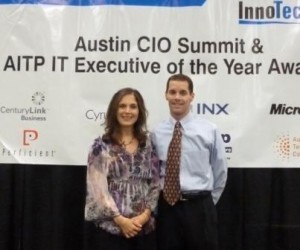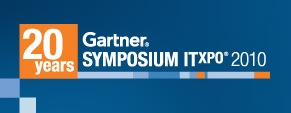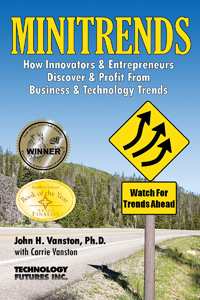InnoTech Conference Teeming With Emerging Trends
October 25, 2011

Sean Lowry, Exe. Dir., Innotech and Carrie Vanston, Co-Author, MINITRENDS at Innotech Conference, Photo by Sloan Foster
I’ve attended the InnoTech Conference and Expo and its associated eMarketing Summit for several years now and always learn a lot. This year I wanted to pass on some comments from experts that I heard yesterday relating to emerging trends that are becoming more and more important:
Sean Lowry, of the very successful InnoTech series, always does a great job of making sure everything runs smoothly. I was even able to steal him for a minute to ask what emerging trends he saw coming. He told me, “I see continued convergence of all the different technologies we are seeing here today. Development of mobile applications and host applications in the cloud are particularly important. There is so much video activity and a lot of it is being hosted in the cloud now.”
I asked Giovanni Galluci, social media expert and Dallas photographer what he thinks the next trend in social media is going to be. He said, “Getting over it. Everyone is burnt out with all the hype and now people are looking for more meaning in social media. Twitter is ridiculous. Those who do marketing are beginning to realize it. Online social media is becoming part of the umbrella of marketing, which is where it belongs. Social media is becoming more commodatized—as in more of a commodity.”
He gave several great hints about Facebook including that Facebook ads are the best way to grow a fan base; Facebook is the 2nd largest search engine, so take advantage of it (including using pictures with metatags, main key words in description, etc.); and put Facebook info on all your printed matter including cards and bills.
I chatted with William Leake, CEO of Apogee Search Marketing, and his take was that “More and more advertising presence is going to be driven by physical location. If you don’t have a physical location strategy, you are going to lose.”
Craig Wax, CEO of Invodo and a video expert, had a lot to say about the future of video marketing. According to Craig, “In the future, no one is going to stand in line anymore. Offline and online is no longer relevant. This is already starting to happen and it is going to become ubiquous.” He added that “QR readers are going to be incorporated into devices and the present obstacles to their use will be chipped away.” (On a side note, Craig was most recently the Senior Vice President and General Manager at Match.com. That had to be an interesting job!)
According to Pat Scherer, Web and Mobile Deployment Manager at The Detail Person, “Mobile space is going to be huge. With the explosion of devices, I think it’s going to make a huge impact on the retail industry. Not only for payments, but for creating local-based experiences utilizing mobile social media. I anticipate this leveling the playing field with e-commerce.”
Finally, I got to chat briefly with siblings Kevin Olsen and Kerri Olsen, Co-Founders of the Austin Grand Prix. Having Formula 1 in Austin exciting!
Cheers,
Carrie Vanston
Media/Marketing Director, Technology Futures, Inc.
Co-Author, MINITRENDS: How Innovators & Entrepreneurs Discover & Profit From Business & Technology Trends
“Nine Emerging Minitrends to Watch” by Dr. John H. Vanston, MINITRENDS Author & Chairman, TFI
December 28, 2010
 Happy holidays to Minitrends blog readers! We appreciate your interest in our Minitrends posts and activities. As we start the new year, there will be many opportunities for those who are alert enough to recognize emerging trends, perceptive enough to realize their importance, and clever enough to take advantage of them. Here I suggest nine Minitrends—emerging trends that will become significantly important within 2-5 years, but are not yet generally recognized—that are well worth examining for possible action by those ambitious individuals who seek to start new ventures or keep existing businesses innovative and competitive.
Happy holidays to Minitrends blog readers! We appreciate your interest in our Minitrends posts and activities. As we start the new year, there will be many opportunities for those who are alert enough to recognize emerging trends, perceptive enough to realize their importance, and clever enough to take advantage of them. Here I suggest nine Minitrends—emerging trends that will become significantly important within 2-5 years, but are not yet generally recognized—that are well worth examining for possible action by those ambitious individuals who seek to start new ventures or keep existing businesses innovative and competitive.
Unlike megatrends, Minitrends are of a scope and importance to offer attractive opportunities to individual entrepreneurs, decision-makers in small and mid-size businesses, innovative thinkers in large companies, and adventuresome investors. In my new book, MINITRENDS: How Innovators & Entrepreneurs & Discover & Profit From Business & Technology Trends, I categorize the nine Minitrends below to those most applicable to different-sized groups. (In the book, I also discuss the background, current trends, and business opportunities of each of these Minitrends in more depth.) I do the same categorization below, but in reality, all provide opportunities to perceptive individuals in all-sized businesses.
Minitrends Particularly Applicable to Individuals or Small Groups of Individuals:
1. Expanding Involvement in Virtual Worlds (Free Virtual Worlds book excerpt available):
Virtual worlds are computer-based platforms that allow participants to engage in a wide range of real-world type activities, e.g., buying and building virtual world property, furnishing virtual world homes and offices, producing and selling virtual world goods, traveling, taking part in virtual world social activities such as parties and fundraisers, and communicating with other participants. Increasingly, virtual worlds are being used for educational purposes, product advertisements, new product modeling and testing, identification of new markets, and uncovering unexpected problems with new marketing programs.
2. Support for People Working at Home:
Although an increasing number of people are now conducting all or part of their work at home, these people often find they miss interacting with others and miss the convenience of facilities, equipment, and administrative support. A number of solutions are emerging to better meet the needs and desires of people working at home, including small offices or meeting rooms that can be rented by the day or the hour; chat rooms where people can meet informally to discuss ideas; semiformal groups that meet regularly to establish person-to-person interactions; and temporary support staffs organized to provide administrative assistance as needed.
3. Expanding Capabilities of Advanced Websites:
Although the World Wide Web had proven to be extremely popular, many believed a more interactive platform that took advantage of the Web’s power to communicate would be desirable (Web 2.0). Programmers are now expanding the capabilities of the Web to substitute computer activities for human activities, particularly activities that are repetitive, burdensome, and uninteresting (Web 3.0). Many believe Web 3.0 will eventually lead to effective artificial intelligence that can interact with humans in natural language.
Minitrends Particularly Applicable to Small and Medium-Size Companies:
4. Increasing Interest in Privacy:
Recent advances in technology, together with an increasing willingness of many to make personal information more easily available are threatening traditional concepts of privacy in terms of messaging, personal profiles, and identity. Techniques for countering these invasions of privacy, such as personal caution, technology aids, and group action are now being developed.
5. New Approaches to Giving and Receiving Advice:
Individuals and organizations commonly seek expert advice when making important decisions. In providing such advice, large consulting firms with large, multidisciplinary staffs, well-structured processes and procedures, huge computer capabilities, and long-standing reputations have traditionally had a major advantage. However, the ever-increasing power and ubiquity of information gathering, processing, and communicating technologies, small and medium-size consulting groups are often able to give more focused, timely, and user-friendly advice than the larger firms.
6. Evolution of Meaningful Maturity:
The twin trends of increasing life spans and decreasing retirement ages have caused a steady increase in retirement years. Because of social, personal interest, and/or financial reasons, many older individuals are either staying in their jobs longer or returning to the workforce. Their ability to utilize their experience, skills, and dedication effectively will depend on their current capabilities, their desires, and open opportunities to those willing to assist them.
Minitrends Particularly Applicable to Large Companies:
7. Advances in Digital Manufacturing:
Advanced digital manufacturing (ADM) processes build complex, custom-made parts by the addition of successive layers of material rather than traditional machining processes that cut, bend, and machine a part from stock material. The processes allow quicker production of prototypes and small production runs at a much lower cost. Recent ADM advances, including improved yield rates, reduced time-to-market, increasing variety of materials, and advances in 3D modeling software, have made ADM processes increasingly attractive to many manufacturers.
8. Increasing Electricity Use in Manufacturing:
The characteristics of electric power, such as high power density, no heat transfer medium requirements, controlled energy distribution, reduced material waste, and less environmental impacts, provide a number of benefits to manufacturing processes. Its use, however, has been limited by its relatively high cost. A number of factors, including advances in control technologies, changing customer needs, global competition, and increasing concern about the environment, are driving an increasing growth in the use of electricity in industrial processes.
9. New Applications of Nanotechnology:
When many substances are reduced to nano-size (100 nanometers or less) they often exhibit very different physical, electrical, chemical, and optical properties from the same substance at macro-size. These new properties often provide very unique and useful characteristics to nano-materials that can be used in a wide range of practical applications, such as cancer treatment, very high strength materials, special electronic systems, and water purification. Improved production techniques, decreased costs, and growing experience and understanding are increasing the practical applications of nanotechnologies
Minitrend involvement can give you a way to separate yourself from your colleagues and contemporaries. It provides a means for materially improving your business situation, your financial standing, and your personal satisfaction. I hope the Minitrends listed above will assist you or inspire you to launch your own exciting, profitable Minitrend Adventure that allows you to utilize your imagination, your logic, your innovative nature, and your basic good sense in the coming year.
Copyright 2011. Please feel free to reprint this article in whole or part with due credit to: “by Dr. John H. Vanston, MINITRENDS Author and Chairman, Technology Futures, Inc.” Thanks!
IDC Sees Perfect Storm in Portable Computing
December 8, 2010

On December 2, International Data Corporation (IDC), the giant IT research firm out of Framingham, Massachusetts, released its annual predictions for IT in the coming year. The firm is forecasting a perfect storm for IT: a combination of cloud computing, mobile computing, and social networking that threatens to consign desktop PCs to the storage closet.
The author of the survey is IDC’s chief analyst, Frank Gens, who leads IDC’s 1,000 analysts in 110 countries in tracking IT trends. Summarizing this year’s report, Gens sees a nearly complete transformation in the dominant computing platform:
What really distinguishes the year ahead is that these disruptive technologies are finally being integrated with each other — cloud with mobile, mobile with social networking, social networking with ‘big data’ and real-time analytics. As a result, these once-emerging technologies can no longer be invested in, or managed, as sandbox efforts around the edges of the market. Instead, they are rapidly becoming the market itself and must be addressed accordingly.
As the IDC report ripples through the Internet, different players are examining what it means for the future of computing. At ComputerWorld, Sharon Gaudin comments on the surge in social networking, suggesting that business startups will stop building expensive and complicated websites and opt for free Facebook pages instead.
Anuradha Shukla at TechWorld is enthusiastic about IDC’s upbeat predictions for IT expenditures. The report forecasts a 5.7% increase in outlays over 2010, to $1.6 trillion worldwide. IDC sees half of that spending coming from emerging market countries shrugging off the recession.
At PC World, Patrick Thibodeau focuses on IDC’s prediction that shipments of apps-enabled mobile devices — smartphones and tablets — will surpass shipments of PCs in the next 18 months. Thibodeau points out, however, that shipments of PCs are not declining; rather, they are growing, but not nearly as quickly as mobile devices.
Another prediction that is sure to catch the eye of venture capital firms: Gens says that nearly a third of the major players in social networking will be bought up in the coming year by the likes of Oracle, Microsoft, HP, and IBM, who need to get in the game.
While many others futurists we have covered on the Minitrends blog have made similar predictions about the growth in cloud computing, mobile computing, and social networking, none of them have joined them together with such a powerful vision of a whole new way of working that Frank Gens brings to IDC’s report.
What do you think is coming in 2011? Do you think it will be just more of the same, or the beginning of a totally new platform, as the IDC report speculates? We welcome your comments.
STEVE O’KEEFE
News Editor, Minitrends Blog
Source: “IDC Predicts Cloud Services, Mobile Computing, and Social Networking to Mature and Coalesce in 2011, Creating a New Mainstream for the IT Industry,” IDC Press Release, 12/02/10
Source: “Business will get more social in 2011, IDC says,” ComputerWorld, 12/06/10
Source: “Cloud services, mobile computing and social networking to mature in IT industry,” TechWorld, 12/07/10
Source: “In historic shift, smartphones, tablets to overtake PCs,” PC World, 12/07/10
Photo by davedehetre (David DeHetre), used under its Creative Commons license.
Technology Trends for Entrepreneurs
December 6, 2010

Android-operated microwave oven, from Touch Revolution video.
Entrepreneurs don’t only create new technology trends, they also use them to take care of businesses. One example is the trend away from using in-house journalists to using freelance journalists to using custom content farms.
An example of an entrepreneur who has successfully mined the Minitrend of content farming is Jonathan Blum. Blum has shifted from a career in broadcast journalism, where he worked for MTV and covered the O.J. Simpson trial for ABC News, among other accomplishments, to a career in custom journalism through his award-winning startup, Blumsday.
Blumsday provides custom content for high-end clients, including CNN and TheStreet. His articles are regularly featured in Entrepreneur magazine. His work earned a Best in Business Award from the Society of American Business Editors and Writers.
One of Blum’s recent creations for Business Insider is a list of the top tech trends for entrepreneurs or, as he puts it,
[…] the top 25 tech tips, trends and megatrends: what’s new now, what will be new tomorrow and what you can expect to grapple with even farther down the road.
I would argue that most of these are “minitrends” rather than “megatrends” — that is, trends that show the likelihood of widespread adoption in the next two to five years and are the byproduct of such megatrends as the spread of the Internet, the growth of mobile devices, or the need for alternative energy sources.
The first minitrend I notice is the increasing use of slideshows instead of text to render the forecasts of pundits. Last week, we reviewed the top 10 tech trends of veteran computer journalist Eric Lundquist, who also presented his picks in slideshow format. We also covered Verizon’s top tech trends, which were presented with video — another Minitrend we expect to see more of in the coming years.
Many of the trends on Blum’s list will already be familiar to readers of this blog. Some of the less typical ones include:
- Touch Kiosks — Blum suggests that using inexpensive touchscreens from companies such as HP and Acer can save a bundle in self-serve customer service.
- Server Simplicity — New products combine “phone servers, e-mail servers, routers, document servers and firewalls into a single low-cost device.”
- Smart Boards for Smarter Presentations — BoxLight and Epson make portable smart boards that take presentations way past the PowerPoint.
- Apps for Your Apps — New apps that run on your household appliances, such as washers and dryers, TVs and microwave ovens. No fooling. Check out the Engadget review.
- Automatic Decision-Making — As computers get smarter, they can do more of our work for us. Entrepreneurs look forward to the day when they can ask the computer to find the 20 best venture capital prospects for a business, then return after a coffee break to find a quality list waiting. Blum points to Google’s Aardvark as an early example of an intelligent assistant.
- Virtual Assistant — Using a bot to represent you at meetings, recording what happens and answering questions by accessing all your computer files, may be more than five years away, but it’s still fun to ponder.
Blum has lots of other tips in his presentation — especially for the eco-conscious entrepreneur interested in energy-saving technologies. I recommend you take his presentation for a ride. It’s a quick trip that really delivers do-it-now ideas for entrepreneurs on the go.
STEVE O’KEEFE
News Editor, Minitrends Blog
Source: “The Future-Proof Entrepreneur: 25 New Tech Trends You Need To Know About,” Business Insider, 11/14/10
Source: Blumsday, undated
Image: Screen capture from Touch Revolution video presentation, used under Fair Use: Reporting.
Lundquist: Service Is Top Tech Trend for 2011
December 1, 2010
 December marks the peak season for looking back on trends from the previous year and forward to trends in the coming year. We’d like to start the month at the Minitrends Blog by sharing the forecasts of famous prognosticators in technology trends to see where they are pointing.
December marks the peak season for looking back on trends from the previous year and forward to trends in the coming year. We’d like to start the month at the Minitrends Blog by sharing the forecasts of famous prognosticators in technology trends to see where they are pointing.
First up is Eric Lundquist. Lundquist is a fixture at Ziff Davis Enterprise, where he has ridden the waves of publishing trends as he reports on technology trends. The Harvard-educated scientist began his career as a journalist (you remember what those are, don’t you?), honing his craft as a daily newspaperman. A newspaper is collection of alphabet in ink on paper that was written yesterday, about today, and is worthless tomorrow.
Lundquist joined Ziff Davis back when eWeek was named PC Week, and quickly rose to editor-in chief of that publication. Following his own advice that video is growing as a method of information delivery, Lundquist moved into video production as creator of CIO Insight, a program on The Pulse Network, which combines streaming video with social networking.
In 2009, Lundquist revealed a love-hate relationship in his technology forecast for 2010. Along with the usual suspects (cloud computing, the migration to mobile, etc.), Lundquist expected CIOs to suffer from whiplash as the economy cut their budgets at a time when IT should be growing its budget. He has similar mixed feelings over social networks, seeing them as a growing trend and a growing source of embarrassment for thoughtless executives.
In his new forecast for 2011, the operative word is “service.” Lundquist predicts that most CIOs will have to evaluate and purchase software as a service in 2011. He also sees the rise of “apps” allowing employees to test and choose services rather than the CIO. He sees social networking, tablets, and mobile platforms all working hard to service business and B2B users who need to communicate on closed networks. He concludes his forecast by lauding the Apple Store for its $99/year training service that has created real-world (not virtual) communities of users.
Mixed-in with Lundquist’s predictions for 2011 are some of the usual suspects: the continuing migration to mobile, cloud computing, virtualization, and tablets. Included is his steadfast belief that “video will take a front seat for businesses to provide new product details, showcase executives, and create how-to explanations for their products and services.” Could this be the last time we see Eric Lundquist’s predictions in print? Enjoy the alphabet while you can.
STEVE O’KEEFE
News Editor, Minitrends Blog
Source: “Lundquist’s Top Tech Trends for 2011,” CIO Insight, 11/19/10
Source: “Ten Top Tech Stories of 2009,” CIO Insight, 12/15/09
Source: “CIO Insight,” The Pulse Network
Photo courtesy of fdecomite, used under its Creative Commons license.
Intelligence Economy Has Arrived, Says Gartner Guru Sondergaard
October 21, 2010
 Peter Sondergaard, head of research for consulting giant, Gartner, Inc., in his opening remarks at the Gartner Symposium in Orlando, Florida, on October 18, forecast that “we are on our way to an IT-driven intelligence society,” according to Michael J. Miller on PC Magazine‘s Forward Thinking blog.
Peter Sondergaard, head of research for consulting giant, Gartner, Inc., in his opening remarks at the Gartner Symposium in Orlando, Florida, on October 18, forecast that “we are on our way to an IT-driven intelligence society,” according to Michael J. Miller on PC Magazine‘s Forward Thinking blog.
Miller is the former Chief Content Officer for Ziff Davis Media and the editor of Forward Thinking. His coverage of Sondergaard’s remarks is extensive and compelling. He quotes Gartner guru Sondergaard as saying:
By 2012, the Internet will be 75 times larger than it was in 2002.
Gartner’s Symposium doubles as an Information Technology (IT) expo. Ten days ago, Gartner released its much-hyped Hype Cycle, boosting visibility in advance of the big event. We criticized the “emerging technology” Hype Cycle here for excluding social networking.
According to Miller, Sondergaard included “social computing” in his list of the top four trends driving IT in his opening remarks. The other three are context-aware computing, pattern-based strategy, and cloud computing, which Gartner’s own HypeCycle says is “past its peak.”
Miller quotes Sondergaard:
Information will be the oil of the 21st century.
In their book, MINITRENDS, John H. Vanston and Carrie Vanston cover the Minitrend of Increasing Use of Electricity in Industrial Processes, where they discuss the concept that the value of goods increases with the amount of information contained in them:
Manufacturing can be defined as the transformation of materials from one form to another more valuable form using energy and information. In general, the greater the information content of the process, the greater the efficiency, the smaller the waste of material and energy, and the smaller the pollution-producing side streams will be. For example, sand can be used as filler for asphalt, as a component of fine china, or as a ingredient in an electronic computer chip. The basic difference between these uses is the amount of information embedded in the silicon (sand) during the production process. Electrical processes can be used to materially increase information content to material.
That mindbending little excerpt comes courtesy of the Edison Electric Institute. It’s one of the interesting trends John and Carrie have uncovered in this book.
If you are looking for a Minitrend Adventure, think about how you can increase the information content in the things around you — before someone else does.
STEVE O’KEEFE
News Editor, Minitrends Blog
Source: “Four Big Trends Changing Computing, Gartner Says,” PCMagazine, Forward Thinking Blog, 10/18/10
Source: Gartner Symposium Live Blog (SymLive), 10/17/10 – 10/21/10.
Image of the Gartner Symposium 2010 logo is used under Fair Use: Reporting.


